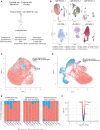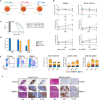Preneoplastic somatic mutations including MYD88L265P in lymphoplasmacytic lymphoma
- PMID: 35044826
- PMCID: PMC8769557
- DOI: 10.1126/sciadv.abl4644
Preneoplastic somatic mutations including MYD88L265P in lymphoplasmacytic lymphoma
Abstract
Normal cell counterparts of solid and myeloid tumors accumulate mutations years before disease onset; whether this occurs in B lymphocytes before lymphoma remains uncertain. We sequenced multiple stages of the B lineage in elderly individuals and patients with lymphoplasmacytic lymphoma, a singular disease for studying lymphomagenesis because of the high prevalence of mutated MYD88. We observed similar accumulation of random mutations in B lineages from both cohorts and unexpectedly found MYD88L265P in normal precursor and mature B lymphocytes from patients with lymphoma. We uncovered genetic and transcriptional pathways driving malignant transformation and leveraged these to model lymphoplasmacytic lymphoma in mice, based on mutated MYD88 in B cell precursors and BCL2 overexpression. Thus, MYD88L265P is a preneoplastic event, which challenges the current understanding of lymphomagenesis and may have implications for early detection of B cell lymphomas.
Figures







References
-
- Wijewardhane N., Dressler L., Ciccarelli F. D., Normal somatic mutations in cancer transformation. Cancer Cell 39, 125–129 (2020). - PubMed
-
- Yoshida K., Gowers K. H. C., Lee-Six H., Chandrasekharan D. P., Coorens T., Maughan E. F., Beal K., Menzies A., Millar F. R., Anderson E., Clarke S. E., Pennycuick A., Thakrar R. M., Butler C. R., Kakiuchi N., Hirano T., Hynds R. E., Stratton M. R., Martincorena I., Janes S. M., Campbell P. J., Tobacco smoking and somatic mutations in human bronchial epithelium. Nature 578, 266–272 (2020). - PMC - PubMed
-
- Martincorena I., Fowler J. C., Wabik A., Lawson A. R. J., Abascal F., Hall M. W. J., Cagan A., Murai K., Mahbubani K., Stratton M. R., Fitzgerald R. C., Handford P. A., Campbell P. J., Saeb-Parsy K., Jones P. H., Somatic mutant clones colonize the human esophagus with age. Science 362, 911–917 (2018). - PMC - PubMed
-
- Lawson A. R. J., Abascal F., Coorens T. H. H., Hooks Y., O’Neill L., Latimer C., Raine K., Sanders M. A., Warren A. Y., Mahbubani K. T. A., Bareham B., Butler T. M., Harvey L. M. R., Cagan A., Menzies A., Moore L., Colquhoun A. J., Turner W., Thomas B., Gnanapragasam V., Williams N., Rassl D. M., Vöhringer H., Zumalave S., Nangalia J., Tubío J. M. C., Gerstung M., Saeb-Parsy K., Stratton M. R., Campbell P. J., Mitchell T. J., Martincorena I., Extensive heterogeneity in somatic mutation and selection in the human bladder. Science 370, 75–82 (2020). - PubMed
Publication types
MeSH terms
Substances
LinkOut - more resources
Full Text Sources
Medical
Molecular Biology Databases

